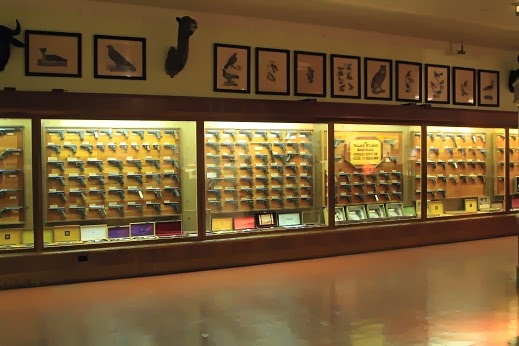The first stop was at a historic Sinclair gas station located west of Halltown. We had a nice visit with the owner, Gary Turner, and he allowed us to walk around the property to take pictures. He also drew us a map on how to find Red Oak II, which is conglomerate of old buildings and other artifacts relocated to a site north of Route 66, about 30 miles farther west.
The next stop was Spencer, which is just down the road and mostly deserted.
The owner of Red Oak II is a private collector and has reportedly spent over $2 million collecting historic artifacts, but he doesn't charge a fee to come in and walk around the property. He even had a homemade Ozark limousine. Interesting place!
At the outskirts of Carthage, I had to stop and take a picture of the World Famous Flying Manure Spreader. Since this is a family site, I can not disclose the Manure Spreader's nickname; but you can probably find it on the internet.
In Carthage we toured the "Battle of Carthage" Civil War Museum, then decided to take a side trip to Lamar to visit the Harry S. Truman's birth place (he was born at home) --- and another quilt shop!
Returning to Carthage we toured the Powers Museum that was featuring, you guessed it, a traveling national exhibit of Route 66 quilts. A side trip was also made to the George Washington Carver National Monument, but it was closed.
Before the movie Cars was released, Riverton and nearby Galena, Kansas, were not known tourist destinations. However, when the Pixar staff was making a research trip on Old Route 66 for the movie Cars, they just happened to stop at a country store in Riverton and met a man that could twist his feet backwards 180 degrees and walk in reverse. This became one of the inspirations for the Mater character in the Cars movie and his ability to drive backwards. The other inspiration for Mater was a rusty old boom truck that is currently based at a restored Kan-O-Tex Service Station in Galena. After the Cars movie was released, the Pixar working model make-up truck (now called "Tow Tater") was moved to Galena and parked next to the original boom truck that was the inspiration for Mater.
Continuing westward on Route 66, we encountered a detour that went north for a number of miles and placed us in the vicinity of "Big Brutus," the second largest electric shovel in the World. Since we had stopped at a number of quilt shops on this trip, it was time to stop at male-type attraction.
Big Brutus can be seen from miles away, as it stands 16 stories tall, weighs 11 million pounds, has a 90 cubic yard dipper (approximately 150 tons capacity, which is enough material to fill three railroad cars), and it can reach speeds of up to 0.22 miles per hour. The inside of the cab is larger than the inside of most houses.
The shovel was originally used to remove overburden that covered the subsurface coal deposits, but in 1974 it became too expensive to operate the shovel; so the shovel was donated to the State of Kansas, along with 16 acres of land and $100,000 for restoration work. (Yes! That is a person standing in front of the dipper! Put on your glasses and get up close to the screen!)
When we arrived in Oswego, the streets were blocked off because they were having a marathon race with other celebrations to follow in the afternoon. While we were driving around the downtown detour, I had to stop to photograph a beautiful red tree in someone's front yard (Sorry! The picture does not do justice to the beauty of the tree.)
Our last stop in Kansas was in Coffeyville to visit the famous site of the October 5, 1892 Dalton Gang raid, when they attempted to rob two local banks at the same time. Unfortunately for the Daltons, they were recognized by local citizens when they rode into town, so the local citizens armed themselves and were waiting for the gang when they exited the banks. The ensuing gun battle left eight men dead and four wounded. All of the gang members except Emmett Dalton were killed. Emmett was severely wounded and not expected to live, but he recovered and spent the next 14 years in prison.
In Nowata, Oklahoma, we stopped by the Nowata County Historical Society Museum, which contains a lot of old mining and well drilling equipment. It was interesting to note that they had an old steam boiler that was very similar to the one at Lees Ferry in Arizona (see RonnieAdventure #04, May 13, 2012), except this boiler is in much better condition.
Woolaroc is located about 12 miles southwest of Bartlesville (Oklahoma) and was established in 1925 on 3,700 acres of land as a wildlife preserve and a museum for the Phillips collection of "one of the world's most unique collection of Western art and artifacts." And the original herd of buffalo came from Pierre, South Dakota.
The collection of artifacts includes one of the finest and most complete collections of Colt Firearms in the World, and the Woolaroc aircraft that won the 1927 Dole Air Race from California to Hawaii. The day we visited the museum, there was a traveling Lewis & Clark art exhibit that was very informative and well displayed. As an added bonus, when we walked out of the museum, one of the bushes in front of the building was covered with butterflies!
After 11 days and 1,452 driving miles, we arrived back in Wichita in time to catch our flight home!































No comments:
Post a Comment